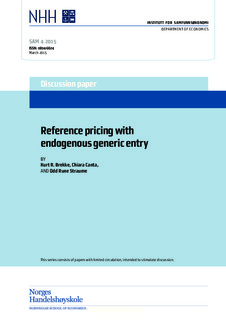| dc.description.abstract | In this paper we study the effect of reference pricing on pharmaceutical prices and expenditures when generic entry is endogenously determined. We develop a Salop-type model
where a brand-name producer competes with generic producers in terms of prices. In the
market there are two types of consumers: (i) brand biased consumers who choose between
brand-name and generic drugs, and (ii) brand neutral consumers who choose between the
di¤erent generic drugs. We find that, for a given number of firms, reference pricing leads
to lower prices of all products and higher brand-name market shares compared with a reimbursement scheme based on simple coinsurance. Thus, in a free entry equilibrium, the
number of generics is lower under reference pricing than under coinsurance, implying that
the net e¤ects of reference pricing on prices and expenditures are ambiguous. Allowing for
price cap regulation, we show that the negative e¤ect on generic entry can be reversed, and
that reference pricing is more likely to result in cost savings than under free pricing. Our results shed light on the mixed empirical evidence on the effects of reference pricing on generic
entry. | nb_NO |
